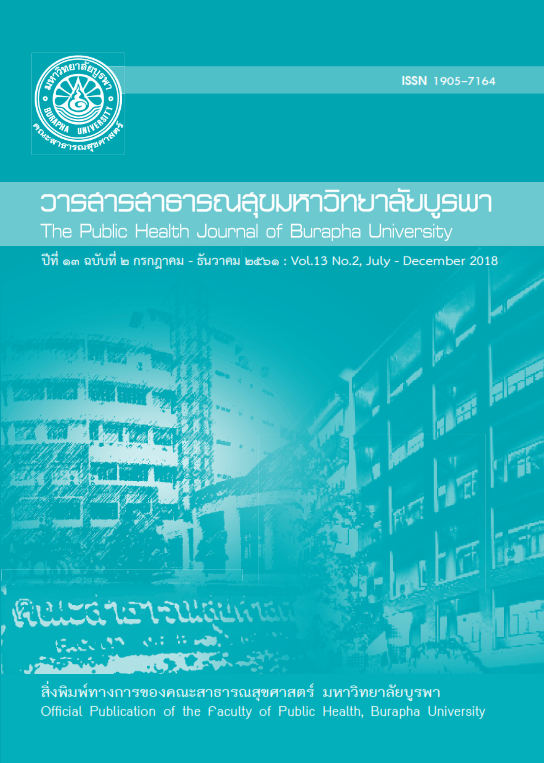การศึกษาความสัมพันธ์ระหว่างการรับสัมผัสสารโทลูอีน ในบรรยากาศการทำงานกับระดับไนตริคออกไซด์ ของลมหายใจออกของพนักงานในโรงงานผลิตรองเท้าแห่งหนึ่ง
Main Article Content
บทคัดย่อ
การศึกษาแบบภาคตัดขวาง โดยศึกษาการรับสัมผัสสารโทลูอีนในบรรยากาศการทำงานและระดับไนตริคออกไซด์ของลมหายใจออกของพนักงานในโรงงานผลิตรองเท้าแห่งหนึ่ง กลุ่มตัวอย่างเป็น พนักงานที่รับสัมผัสสารโทลูอีนขณะปฏิบัติงานจำนวน 150 คน โดยพนักงานส่วนใหญ่เป็นเพศหญิง (ร้อยละ 87.3) มีอายุเฉลี่ย 29.59 ปี ทำงานวันละ 12 ชั่วโมง (ร้อยละ 28.0) รองลงมาวันละ 10 ชั่วโมง (ร้อยละ20.7) และทำงาน 6 วันต่อสัปดาห์ ร้อยละ 100.0 เก็บตัวอย่างการรับสัมผัสสารโทลูอีนในบรรยากาศการทำงานโดยใช้ Organic Vapor Monitor (3M 3500) แบบติดตัวบุคคลในระดับการหายใจตลอดระยะเวลาการทำงานของกลุ่มตัวอย่าง พบว่า กลุ่มตัวอย่าง (n=40) มีค่าเฉลี่ย ± ส่วนเบี่ยงเบนมาตรฐานการรับสัมผัสสารโทลูอีน 615.31 ± 275.849 ppb และปริมาณระดับไนตริคออกไซด์ของลมหายใจออก มีค่าเฉลี่ย ± ส่วนเบี่ยงเบนมาตรฐาน 17.65± 9.569 ppb และเมื่อหาความสัมพันธ์ระหว่างการรับสัมผัสสารโทลูอีนกับระดับไนตริคออกไซด์ของลมหายใจออก พบว่า ไม่มีความสัมพันธ์กัน (r = 0.352 p-value 0.128) แต่อย่างไรก็ตามควรมีการอบรมให้ความรู้ ความเข้าใจถึงอันตรายของสารโทลูอีนและการใช้อุปกรณ์คุ้มครองความปลอดภัยที่ถูกต้องและเหมาะสมต่อไป แม้ว่าการรับสัมผัสจะไม่เกินค่าเสนอแนะของ ACGIH
Article Details
References
2. Chang FK, Chen ML, Cheng SF, Shih TS, Mao IF. Dermal absorption of solvents as a major source of exposure among shipyard spray painters. J Occup Environ Med 2007; 49: 430- 36.
3. Jimenez-Garza O, Marquez-Gamino S, Albores A, Caudillo-Cisneros C, Carrieri M, Bartolucci GB, Manno M. CYP2E1 phenotype in Mexican workers occupationally exposed to low levels of toluene. Toxicol Lett 2012; 210 (2): 254 – 63.
4. Ongwandee M, Chavalparit O. Commuter exposure to BTEX in public transportation modes in Bangkok, Thailand. J Environ Sci (China) 2010; 22 (3): 397 – 404.
5. Olin AC, Rosengren A, Lissner L, Bake B, Toren K. FCCP, height, age, and atopy are associated with farction of exhaled nitric oxide in a large adult general population sample. Chest. 2006; 130(5): 1319-25.
6. Bohadana AB, Hannhart B, Ghezzo H, Teculescu D. and Zmirou-Navier D. Exhaled nitric oxide and spirometry in respiratory health surveillance. Occupational Medicine 2011; 61:108-14.
7. Mauro Maniscalco, Luigi Grieco, Aniello Galdi, Jon O.N. Lundberg and Matteo Sofia. Increase in exhaled nitric oxide in shoe and leather workers at the end of the work- shift. Occupational Medicine. 2004; 54: 404-7.
8. Baur X. and Barbinova L. Latex allergen exposure increases exhaled nitric oxide in
symptomatic healthcare. Eur Respir J 2005; 25:309-16.
9. Mandiracioglu A, Akgur S, Kocabiyik N, Sener U. Evaluation of neuropsychological symptoms and exposure to benzene, toluene and xylene among two different furniture worker groups in lzmir. Toxico Ind Health. 2011; 27(9): 802-9.
10. Cochran WG. Sampling Techniques (3th Edition). 1977. John Wiley & Sons.
11. Maniscalco M, Luigi Grieco L, Aniello Galdi A, Jon O. N. Lundberg JON, Matteo Sofia M. Increase in exhaled nitric oxide in shoe and leather workers at the end of the work-shift, Occupational Medicine. 2004; 54 (6): 404–407.
12. Hawkins NC, Norwood SK, Rock JC. A Strategy for occupational exposure assessment. 1991. Akron, OH: American Industrial Hygiene Association.
13. ACGIH. Threshold limit values for the chemical substances and physical agents and biological exposure indices. American Conference of Governmental Industrial Hygienists, Cincinnati, Ohio, USA. 2011.
14. Todd LA, Mottus K, Mihlan GJ. A survey of airborne and skin exposure to chemicals in footwear and equipment factories in Thailand. J Occup Environ Hyg. 2008; 5 (3): 169-81.
15. Todd L, Puangthongthub ST, Mottus K, Mihlan G, Wing S. Health survey of workers exposed to mixed solvent and ergonomic hazards in footwear and equipment factory workers in Thailand. Ann Occup Hyg. 2008; 52 (3): 195-205.
16. Tamura K, Jinsart W, Yano E, Karita K, Boudoung D. Particulate air pollution and chronic respiratory symptoms among traffics policemen in Bangkok. Arch Environ Health. 2003; 58(4): 201-7.
17. Hoffmeyer F, Raulf-Heimsoth M, Bruning T. Exhaled breathe condensate and airway inflammation. Curr Opin Allergy Clin Immunol; 2009; 9(1): 16-22.
18. Tungu AM, Bratveit M, Mamuya SD, Moen BE. Fractionnal exhaled nitric oxide among cement factory workers: a cross sectional study. Occup Environ Med; 2013; 70(5): 289-95
